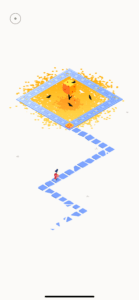A sequel to Monument Valley, Monument Valley 2 is a digital puzzle game developed by Ustwo and can be played on iOS, Android, and Windows platforms. The game developers didn’t have a specific target audience in mind but intended to make this game playable by people who don’t usually play games.
To play Monument Valley 2 as a feminist means to set on a beautiful, soothing journey of growth that centers around the mother-child relationship, which unfolds not just through the embedded narrative of the game, but also through the evolving agency of the characters and the metaphorical puzzle design that magnifies it. Apart from its very feminist theme, this game is also feminist in that the Escher-esque mazes motivate the player to change their perspective on the world, which is advocated by feminist theories and other critical theories alike. This is further reinforced by the aesthetically pleasing visual design and ethereal and mystical music and sound effects, all of which creates a beautiful and engaging gaming experience without the conventional climaxes emphasized by masculine games.

Fig.1: The game starts out with Ro introducing her child to the valley.
As a puzzle-solving game, the puzzles in Monument Valley 2 are connected through a story depicting the changing dynamics of a mother and her child as the child grows up. It starts out with Ro introducing her child to the valley. In the first few puzzles, the child follows Ro wherever she goes. With a blue apparition giving out cues in the transition scenes, Ro is told that the child can’t always follow her mom and needs to learn her own lesson. So in the next few puzzles, we see the child no longer walking by Ro’s side, but following Ro at a distance. The apparition then explains the importance of letting go, after which point the child gets on a boat to start her own journey. The player then solves a series of puzzles with Ro as the only character before solving another set of puzzles with the child as the only character. After the child has cultivated her own skills, she finally reunites with her mom and the two are able to collaborate in solving puzzles. This narrative consisting of 4 stages (following, imitating, separating, and reuniting) is easy for the player to resonate with, since most of us have gone through this process from relying on our mother to becoming independent at some point in our lives. By turning this commonplace process into an adventurous narrative with the mom and the child as the heroes, Monument Valley 2 affirms the emotional labor that women make in raising and educating children. Acknowledgingly, some may criticize this design as perpetuating the familiar gender role where it is always the female that takes care of the child. This character gender choice can indeed be interpreted both ways, so instead of explicitly pointing out helping the kids grow is “the work our mothers left for us”, the game can make the parent character gender neutral.

Fig. 2: Instead of explicitly pointing out helping the kids grow is “the work our mothers left for us”, the game can make the parent character gender neutral.
Moreover, Monument Valley 2 cleverly fuses this narrative with the mechanisms of the game in 2 aspects: The first aspect is the agency / player control of the characters. In the following stage, the player decides where Ro walks and the child would just follow along. In the imitation stage, although the child is no longer by her mom’s side, she still follows her mom at a distance. So in order to have the child trigger some mechanism in the puzzle, the player has to move Ro in the same direction. In the separation stage, the player plays the puzzles with a single character, either Ro or her child. In the reunification stage, after the child has learnt her skills and becomes independent, the player can move these two characters separately. The second aspect is the design of the puzzles, which is especially salient in the imitation stage. Given that the two characters move in parallel in this stage, the puzzles are also designed in such a way that there are two parallel paths, one for Ro and the other for the child. Tying the narrative closely to the game mechanisms enhances the feminist element by allowing the player to instantiate the feminist narrative through their moves in the game.

Fig. 3: The child goes on her own journey in the separation stage.
As a feature that distinguishes puzzles in Monument Valley 2 from those in other games, the need for changing perspectives also embody feminist values. Many puzzles feature intriguing spatial elements that defy the laws of physics. For instance, rotating a monument can connect two levels of different heights, and the character can sometimes walk vertically or even on the ceiling. So the player sometimes has to turn their phone in order to find hidden solutions. This really echoes a major idea in feminist theory that we need to account for the rich variety of different perspectives of individuals with very different circumstances, and not take for granted the mainstream perspective (which is usually the male perspective) as being universally applicable. By introducing all these different ways of seeing the world, the game designers of Monument Valley 2 show how exponentially more fascinating the game can become.
Lastly, the entire game unfolds in a relatively peaceful manner in a “never-ending narrative middle”, without dramatic climax or tension. The soothing music, color schemes with relatively low saturation, and the slow pace of the game together create a very feminist and meditative ambience, which offers the player a sensory and psychologically unique aesthetic experience.
Fig.4: The puzzles are also designed in such a way that there are two parallel paths, one for Ro and the other for the child.



